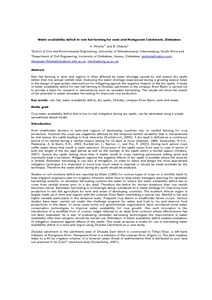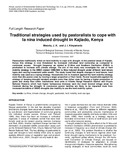The political economy of livestock policy: The case of Djibouti
The political economy of pro-poor livestock policy in Eritrea
Traditional cow and camel milk production and marketing in agropastoral and mixed crop-livestock systems: the case of Mieso District, Oromia Regional State, Ethiopia
This study was conducted to characterize the traditional milk production and marketing system, and to identify constraints and opportunities for further development. It was conducted in Mieso District of Oromia Regional State, located 300 km east of Addis Ababa and at about 200 km east of Adama. Five rural kebeles, Dire Kalu, Gena, Huse Mendera, Hunde Misoma and Welda Jejeba, that have milk production potential were selected. Farmers/agro-pastoralists from each rural kebele were also selected.
Water availability deficit in rainfed farming for semiarid Mzingwane Catchment Zimbabwe
Dehesa model application to acorn production
The Spanish law Real Decreto 1469/2007 about the regulations of quality of Iberian pig meat, establishes limitations to the carrying capacity of Iberian pig in the dehesa (open oak parkland) and forces to the regional governments to make a programs of evaluation of acorn production at the beginning of each campaign, that will have to be based on agronomical, environmental, and topographical criteria, identifying each paddocks through SIGPAC.
Traditional strategies used by pastoralists to cope with la nina induced drought in Kajiado, Kenya
Pastoralists traditionally relied on herd mobility to cope with drought. In the pastoral areas of Kajiado,
Kenya this strategy is now threatened by increased individual land ownership as compared to
communal access. Drought frequency as related to El-Nino and Southern Oscillation (ENSO) is
predicated to increase with climate change. The aim of the study was investigate the use of herd
mobility strategy in the ENSO related 1999/2000 la Nina induced drought under different land tenure
People in marginal drylands. Managing natural resources to improve human well-being
Change in land management practices and governmental policies is urgently needed to reverse the continuing decline of marginal drylands. Marginal drylands are fragile ecosystems that sustain the livelihoods of millions of poor people in developing countries. However, their capacity to provide these services is continuously declining due to desertification, resulting in dwindling land productivity, and affecting human well-being and development opportunities in many marginal drylands.
Sustainable management of marginal drylands:Using science to promote sustainable development. Project findings from Northern Africa to Asia
The world’s drylands are among the most vulnerable ecosystems on our planet. Desertification and land degradation are affecting huge land areas, jeopardizing the livelihoods of millions of people. Unsustainable management practices in dryland cultivation and pastoralism have given rise to widespread soil erosion, reduction of the biological production of soils, reduction of vegetation cover, and depletion of surface and groundwater resources.
Un questionnaire pour la cartographie de la dégradation et de la gestion durable des terres
L’outil cartographique WOCAT-LADA-DESIRE est fondé sur le questionnaire original WOCAT sur la cartographie (WOCAT, 2007). Celui-ci a été développé de façon à accorder plus d’attention aux problèmes de dégradation biologique et de l’eau. Il met davantage l’accent sur les causes directes et socio-économiques de ces phénomènes incluant leurs impacts sur les fonctionnements des écosystèmes.
Анкета по Нанесению на Карту Деградации Земельных Ресурсов и Сбалансированного Землеуправления
Метод картирования ВОКАТ-ЛАДА-ДЕЗИРЕ основывается на исходной анкете картирования ВОКАТ (WOCAT, 2007). Она был расширена чтобы уделить большее внимание таким вопросам как биологическая и водная деградация и придает большее значение непосредственным и социо-экономическим причинам этих феноменов включая их влияния на услуги эко-системы. Она оценивает в форме анкеты какие типы деградации земли в действительности происходят, где и почему и что нужно сделать по этому поводу с точки зрения Сбалансированного ЗемлеУправления (СЗУ).
Altering poverty dynamics with index insurance: northern Kenya’s HSNP+
Abstract not available.








